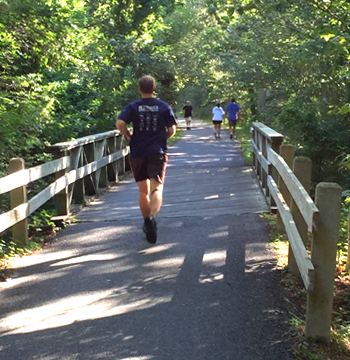Shining Sea Bikeway Improvement
Plans, Engineering, and Specifications (PS&E)
Location: 1 Cowdry Lane, Woods Hole to 157 Locust Street, Falmouth
Applicant: Falmouth Board of Selectmen
Allocation: $53,000
Year/Article: Fall 2015, A35
In 2015, the Planning Department applied to the CPFund for the $103,000 estimated cost of producing plans, specifications and estimates (PS&Es) for both permit and construction purposes in order to improve the Phase 1 section of the Shining Sea Bikeway. Phase 1 begins at Crane Street in Woods Hole and travels northward to Locust Street for 3.2 miles. November 2015 Town Meeting appropriated $53,000 from the CPFund and $53,000 from general revenues to develop the PS&Es.
As part of the 2014 Environmental Bond Bill, the Legislature authorized $890,000 in construction dollars for rehabilitation of the Bikeway’s Phase 1 portion, but no funding for PS&Es. In order for the Shining Sea Bikeway bond authorization to proceed to allocation, engineering plans, erosion control and wetlands permitting are required. PS&Es will allow the Town to negotiate the permitting process, bid the work, and proceed to construction.
The Shining Sea Bikeway is one of the most valued outdoor and recreational resource in Falmouth – by both residents and the hundreds of thousands of year-round visitors the Town receives. The Chamber of Commerce reports that the most frequently asked question by Falmouth visitors is “Where is the Shining Sea Bikeway?”
The Phase 1 section of the bikeway was constructed in the late 1970s and does not meet current standards found in Phases 2, 2B & 3 of the bikeway, from Depot Avenue to County Road. Its width varies from the minimum 10 feet for a Class I bikeway, and the depth of construction for the base and bituminous concrete overlay are less than the minimum 8 and 2.5 inches respectively. Phase 1 of the Bikeway runs along Vineyard Sound, where heavy erosion and runoff occur during storms and storm surges. Rehabilitation work will include significant measures to manage erosion, to direct runoff away from critical wetlands resources, and to install new “soft” erosion control measures.
After the necessary permits have been obtained, it is expected that construction on the Phase 1 section of the Bikeway will begin in April 2016 and be completed in April 2017.




